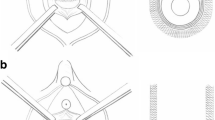Abstract
Objective
The aims of this study are to report the efficacy of retropubic urethrolysis, vaginal urethrolysis, and cutting of synthetic suburethral slings in treating postoperative voiding dysfunction that occurs after anti-incontinence surgery and to report the recurrence rate of stress urinary incontinence (SUI).
Methods
All patients from January 1996 to October 2003 who presented with voiding dysfunction following an anti-incontinence procedure and who subsequently underwent either retropubic urethrolysis, vaginal urethrolysis, or synthetic suburethral sling takedown were included in the study. Pre- and postoperative irritative symptoms (urinary frequency or urgency), obstructive symptoms (hesitancy, voiding difficulty, and incomplete emptying), and stress urinary incontinence symptoms were obtained in a standardized fashion. The Incontinence Impact Questionnaire and Urogenital Distres Invetory quality of life (QOL) questionnaires were also obtained to objectify these symptoms. Other objective postoperative analysis included simple uroflowmetry, measurement of postvoid residual (PVR), and simple or subtracted cystometry.
Results
Forty-four patients were included in the study (suburethral sling takedown=14, vaginal urethrolysis=20, and retropubic urethrolysis=10), 77% of whom had objective follow-up. Preoperatively, 31 patients (70.5%) had irritative symptoms, 41 (93.2%) had obstructive symptoms, and 6 (13.6%) had symptoms of stress urinary incontinence (SUI), while postoperatively, these symptoms were found in 30 (68.2%), 11 (25.0%), and 18 (40.9%), respectively. Postoperatively, 6 patients (17.6%) had a PVR> 100 cc, 5 patients (14.7%) had a bladder contractions, and 16 patients (47.1%) demonstrated the sign or diagnosis of (SUI). Additionally, there was a statistically significant improvement in both QOL questionnaires.
Conclusions
Various surgical approaches may be used to treat voiding dysfunction following an anti-incontinence procedure. Following a vaginal or retropubic urethrolysis or takedown of a synthetic suburethral sling, obstructive symptoms are likely to improve, irritative symptoms may remain unchanged, and almost half will develop recurrence of SUI.
Similar content being viewed by others
References
Dorflinger A, Monga A (2001) Voiding dysfunction. Curr Opin Obstet Gynecol 13:507–512
Zimmern PE, Hadley HR, Leach GE, Raz S (1987) Female urethral obstruction after Marshall–Marchetti–Krantz operation. J Urol 138:517–520
McDuffie RW, Litin RB, Blundon KE (1981) Urethrovesical suspension (Marshall–Marchetti–Krantz). Experience with 204 cases. Am J Surg 141:297–298
Akpinalr H, Cetinel B, Demirkesen O (2000) Long-term results in Burch colposuspension. Int J Urol 7:119–125
Ward KL, Hilton P, Browning J (2000) A randomized trial of colposuspension and tension free vaginal tape for primary stress incontinence. Neurourol Urodyn 19:386–388
Holschneider CH, Solh S, Lebhertz TB, Montz FJ (1994) The modified Pereyra procedure in recurrent stress urinary incontinence: a 15-year review. Obstet Gynecol 83:573–578
Horbach NS (1991) Suburethral sling procedures. In: Ostergard DR, Bent AE (eds) Urogynecology and urodynamics theory and practice, 3rd edn. Williams & Wilkins, Baltimore, pp 413–421
Karram MM, Segal JL, Vassallo BJ, Kleeman SD (2003) Complications and untoward effects of the tension-free vaginal tape procedure. Obstet Gynecol 101:929–932
Karram MM, Miklos JR (1999) Urodynamics: cystometry, voiding studies, urethral pressure profilometry and leak point pressures. In Walters MD, Karram MM, (eds) Urogynecology and reconstructive pelvic surgery, 2nd edn. Mosby, St. Louis, pp 55–93
Abrams P, Cardozo L, Fall M, Griffiths D, Rosier P, Ulmsten U (2003) The standardization of terminology in lower urinary tract function: report from the standardization sub-committee of the International Continence Society. Urology 61:37–49
Karram MM (2001) Retropubic vesicourethrolysis. In: Baggish MS, Karram MM (eds) Atlas of pelvic anatomy and gynecologic surgery, 1st edn. WB Saunders, p 194
Karram MM (2001) Vaginal urethrolysis. In: Baggish MS, Karram MM (eds) Atlas of pelvic anatomy and gynecologic surgery, 1st edn. WB Saunders, pp 492–493
Bump RC, Hurt WG, Elser DM, Theofrastous JP, Addison WA, Fantl JA et al (1999) Understanding lower urinary tract function in women soon after bladder neck surgery. Neurourol Urodyn 18:629–637
Klutke JJ, Klutke CG, Bergman G, Elia G (1999) Urodynamic changes in voiding after anti-incontinence surgery: an insight into the mechanism of cure. Urology 54:1003–1007
Kershen RT, Appell RA (2002) De novo urge syndrome and detrusor instability after anti-incontinence surgery: current concepts, evaluation, and treatment. Curr Urol Rep 3:345–353
Chassagne S, Bernier PA, Haab F, Roehrborn CG, Reisch JS, Zimmern PE (1998) Proposed cutoff values to define bladder outlet obstruction in women. Urology 51:408–411
Blaivas JG, Groutz A (2000) Bladder outlet obstruction nomogram for women with lower urinary tract symptomatology. Neurourol Urodyn 19:553–564
Rosenblum N, Nitti VW (2001) Post-urethral suspension obstruction. Curr Opin Urol 11:411–416
Petrou SP, Brown JA, Blaivas JG (1999) Suprameatal transvaginal urethrolysis. J Urol 161:1268–1271
Nitti VW, Carlson KV, Blaivas JG, Dmochowski RR (2002) Early results of pubovaginal sling lysis by midline sling incision. Urology 59:47–52
Cross CA, Cespedes RD, English SF, McGuire EJ (1998) Transvaginal urethrolysis for urethral obstruction after anti-incontinence surgery. J Urol 159:1199–1201
Foster HE, McGuire EJ (1993) Management of urethral obstruction with transvaginal urethrolysis. J Urol 150:1448–1451
Carr LK, Webster GD (1997) Voiding dysfunction following incontinence surgery: diagnosis and treatment with retropubic or vaginal urethrolysis. J Urol 157:821–823
Author information
Authors and Affiliations
Corresponding author
Rights and permissions
About this article
Cite this article
Segal, J., Steele, A., Vassallo, B. et al. Various surgical approaches to treat voiding dysfunction following anti-incontinence surgery. Int Urogynecol J 17, 372–377 (2006). https://doi.org/10.1007/s00192-005-0018-1
Received:
Accepted:
Published:
Issue Date:
DOI: https://doi.org/10.1007/s00192-005-0018-1




